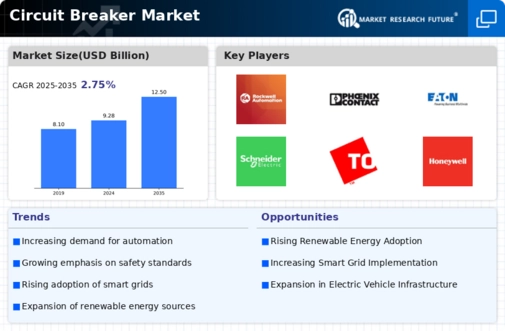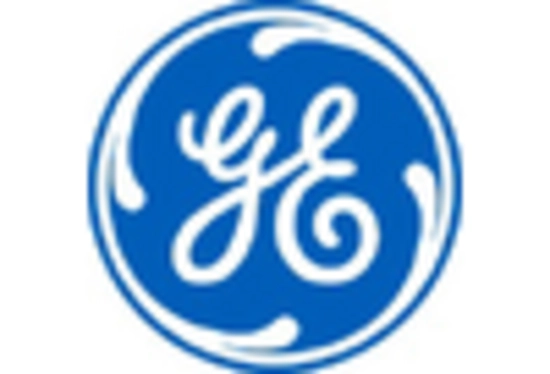Miniature Circuit Breakers
Molded Case Circuit Breakers
Air Circuit Breakers
Hydraulic Magnetic Circuit Breakers
Low Voltage Circuit Breakers
Medium Voltage Circuit Breakers
High Voltage Circuit Breakers
Residential
Commercial
Industrial
Utility
Power Generation
Power Distribution
Renewable Energy
Transportation
North America
Europe
South America
Asia Pacific
Middle East and Africa
North America Outlook (USD Billion, 2019-2035)
North America Circuit Breaker Market by Type
Miniature Circuit Breakers
Molded Case Circuit Breakers
Air Circuit Breakers
Hydraulic Magnetic Circuit Breakers
North America Circuit Breaker Market by Voltage Rating Type
Low Voltage Circuit Breakers
Medium Voltage Circuit Breakers
High Voltage Circuit Breakers
North America Circuit Breaker Market by Application Type
Residential
Commercial
Industrial
Utility
North America Circuit Breaker Market by End Use Type
Power Generation
Power Distribution
Renewable Energy
Transportation
North America Circuit Breaker Market by Regional Type
US
Canada
US Outlook (USD Billion, 2019-2035)
US Circuit Breaker Market by Type
Miniature Circuit Breakers
Molded Case Circuit Breakers
Air Circuit Breakers
Hydraulic Magnetic Circuit Breakers
US Circuit Breaker Market by Voltage Rating Type
Low Voltage Circuit Breakers
Medium Voltage Circuit Breakers
High Voltage Circuit Breakers
US Circuit Breaker Market by Application Type
Residential
Commercial
Industrial
Utility
US Circuit Breaker Market by End Use Type
Power Generation
Power Distribution
Renewable Energy
Transportation
CANADA Outlook (USD Billion, 2019-2035)
CANADA Circuit Breaker Market by Type
Miniature Circuit Breakers
Molded Case Circuit Breakers
Air Circuit Breakers
Hydraulic Magnetic Circuit Breakers
CANADA Circuit Breaker Market by Voltage Rating Type
Low Voltage Circuit Breakers
Medium Voltage Circuit Breakers
High Voltage Circuit Breakers
CANADA Circuit Breaker Market by Application Type
Residential
Commercial
Industrial
Utility
CANADA Circuit Breaker Market by End Use Type
Power Generation
Power Distribution
Renewable Energy
Transportation
Europe Outlook (USD Billion, 2019-2035)
Europe Circuit Breaker Market by Type
Miniature Circuit Breakers
Molded Case Circuit Breakers
Air Circuit Breakers
Hydraulic Magnetic Circuit Breakers
Europe Circuit Breaker Market by Voltage Rating Type
Low Voltage Circuit Breakers
Medium Voltage Circuit Breakers
High Voltage Circuit Breakers
Europe Circuit Breaker Market by Application Type
Residential
Commercial
Industrial
Utility
Europe Circuit Breaker Market by End Use Type
Power Generation
Power Distribution
Renewable Energy
Transportation
Europe Circuit Breaker Market by Regional Type
Germany
UK
France
Russia
Italy
Spain
Rest of Europe
GERMANY Outlook (USD Billion, 2019-2035)
GERMANY Circuit Breaker Market by Type
Miniature Circuit Breakers
Molded Case Circuit Breakers
Air Circuit Breakers
Hydraulic Magnetic Circuit Breakers
GERMANY Circuit Breaker Market by Voltage Rating Type
Low Voltage Circuit Breakers
Medium Voltage Circuit Breakers
High Voltage Circuit Breakers
GERMANY Circuit Breaker Market by Application Type
Residential
Commercial
Industrial
Utility
GERMANY Circuit Breaker Market by End Use Type
Power Generation
Power Distribution
Renewable Energy
Transportation
UK Outlook (USD Billion, 2019-2035)
UK Circuit Breaker Market by Type
Miniature Circuit Breakers
Molded Case Circuit Breakers
Air Circuit Breakers
Hydraulic Magnetic Circuit Breakers
UK Circuit Breaker Market by Voltage Rating Type
Low Voltage Circuit Breakers
Medium Voltage Circuit Breakers
High Voltage Circuit Breakers
UK Circuit Breaker Market by Application Type
Residential
Commercial
Industrial
Utility
UK Circuit Breaker Market by End Use Type
Power Generation
Power Distribution
Renewable Energy
Transportation
FRANCE Outlook (USD Billion, 2019-2035)
FRANCE Circuit Breaker Market by Type
Miniature Circuit Breakers
Molded Case Circuit Breakers
Air Circuit Breakers
Hydraulic Magnetic Circuit Breakers
FRANCE Circuit Breaker Market by Voltage Rating Type
Low Voltage Circuit Breakers
Medium Voltage Circuit Breakers
High Voltage Circuit Breakers
FRANCE Circuit Breaker Market by Application Type
Residential
Commercial
Industrial
Utility
FRANCE Circuit Breaker Market by End Use Type
Power Generation
Power Distribution
Renewable Energy
Transportation
RUSSIA Outlook (USD Billion, 2019-2035)
RUSSIA Circuit Breaker Market by Type
Miniature Circuit Breakers
Molded Case Circuit Breakers
Air Circuit Breakers
Hydraulic Magnetic Circuit Breakers
RUSSIA Circuit Breaker Market by Voltage Rating Type
Low Voltage Circuit Breakers
Medium Voltage Circuit Breakers
High Voltage Circuit Breakers
RUSSIA Circuit Breaker Market by Application Type
Residential
Commercial
Industrial
Utility
RUSSIA Circuit Breaker Market by End Use Type
Power Generation
Power Distribution
Renewable Energy
Transportation
ITALY Outlook (USD Billion, 2019-2035)
ITALY Circuit Breaker Market by Type
Miniature Circuit Breakers
Molded Case Circuit Breakers
Air Circuit Breakers
Hydraulic Magnetic Circuit Breakers
ITALY Circuit Breaker Market by Voltage Rating Type
Low Voltage Circuit Breakers
Medium Voltage Circuit Breakers
High Voltage Circuit Breakers
ITALY Circuit Breaker Market by Application Type
Residential
Commercial
Industrial
Utility
ITALY Circuit Breaker Market by End Use Type
Power Generation
Power Distribution
Renewable Energy
Transportation
SPAIN Outlook (USD Billion, 2019-2035)
SPAIN Circuit Breaker Market by Type
Miniature Circuit Breakers
Molded Case Circuit Breakers
Air Circuit Breakers
Hydraulic Magnetic Circuit Breakers
SPAIN Circuit Breaker Market by Voltage Rating Type
Low Voltage Circuit Breakers
Medium Voltage Circuit Breakers
High Voltage Circuit Breakers
SPAIN Circuit Breaker Market by Application Type
Residential
Commercial
Industrial
Utility
SPAIN Circuit Breaker Market by End Use Type
Power Generation
Power Distribution
Renewable Energy
Transportation
REST OF EUROPE Outlook (USD Billion, 2019-2035)
REST OF EUROPE Circuit Breaker Market by Type
Miniature Circuit Breakers
Molded Case Circuit Breakers
Air Circuit Breakers
Hydraulic Magnetic Circuit Breakers
REST OF EUROPE Circuit Breaker Market by Voltage Rating Type
Low Voltage Circuit Breakers
Medium Voltage Circuit Breakers
High Voltage Circuit Breakers
REST OF EUROPE Circuit Breaker Market by Application Type
Residential
Commercial
Industrial
Utility
REST OF EUROPE Circuit Breaker Market by End Use Type
Power Generation
Power Distribution
Renewable Energy
Transportation
APAC Outlook (USD Billion, 2019-2035)
APAC Circuit Breaker Market by Type
Miniature Circuit Breakers
Molded Case Circuit Breakers
Air Circuit Breakers
Hydraulic Magnetic Circuit Breakers
APAC Circuit Breaker Market by Voltage Rating Type
Low Voltage Circuit Breakers
Medium Voltage Circuit Breakers
High Voltage Circuit Breakers
APAC Circuit Breaker Market by Application Type
Residential
Commercial
Industrial
Utility
APAC Circuit Breaker Market by End Use Type
Power Generation
Power Distribution
Renewable Energy
Transportation
APAC Circuit Breaker Market by Regional Type
China
India
Japan
South Korea
Malaysia
Thailand
Indonesia
Rest of APAC
CHINA Outlook (USD Billion, 2019-2035)
CHINA Circuit Breaker Market by Type
Miniature Circuit Breakers
Molded Case Circuit Breakers
Air Circuit Breakers
Hydraulic Magnetic Circuit Breakers
CHINA Circuit Breaker Market by Voltage Rating Type
Low Voltage Circuit Breakers
Medium Voltage Circuit Breakers
High Voltage Circuit Breakers
CHINA Circuit Breaker Market by Application Type
Residential
Commercial
Industrial
Utility
CHINA Circuit Breaker Market by End Use Type
Power Generation
Power Distribution
Renewable Energy
Transportation
INDIA Outlook (USD Billion, 2019-2035)
INDIA Circuit Breaker Market by Type
Miniature Circuit Breakers
Molded Case Circuit Breakers
Air Circuit Breakers
Hydraulic Magnetic Circuit Breakers
INDIA Circuit Breaker Market by Voltage Rating Type
Low Voltage Circuit Breakers
Medium Voltage Circuit Breakers
High Voltage Circuit Breakers
INDIA Circuit Breaker Market by Application Type
Residential
Commercial
Industrial
Utility
INDIA Circuit Breaker Market by End Use Type
Power Generation
Power Distribution
Renewable Energy
Transportation
JAPAN Outlook (USD Billion, 2019-2035)
JAPAN Circuit Breaker Market by Type
Miniature Circuit Breakers
Molded Case Circuit Breakers
Air Circuit Breakers
Hydraulic Magnetic Circuit Breakers
JAPAN Circuit Breaker Market by Voltage Rating Type
Low Voltage Circuit Breakers
Medium Voltage Circuit Breakers
High Voltage Circuit Breakers
JAPAN Circuit Breaker Market by Application Type
Residential
Commercial
Industrial
Utility
JAPAN Circuit Breaker Market by End Use Type
Power Generation
Power Distribution
Renewable Energy
Transportation
SOUTH KOREA Outlook (USD Billion, 2019-2035)
SOUTH KOREA Circuit Breaker Market by Type
Miniature Circuit Breakers
Molded Case Circuit Breakers
Air Circuit Breakers
Hydraulic Magnetic Circuit Breakers
SOUTH KOREA Circuit Breaker Market by Voltage Rating Type
Low Voltage Circuit Breakers
Medium Voltage Circuit Breakers
High Voltage Circuit Breakers
SOUTH KOREA Circuit Breaker Market by Application Type
Residential
Commercial
Industrial
Utility
SOUTH KOREA Circuit Breaker Market by End Use Type
Power Generation
Power Distribution
Renewable Energy
Transportation
MALAYSIA Outlook (USD Billion, 2019-2035)
MALAYSIA Circuit Breaker Market by Type
Miniature Circuit Breakers
Molded Case Circuit Breakers
Air Circuit Breakers
Hydraulic Magnetic Circuit Breakers
MALAYSIA Circuit Breaker Market by Voltage Rating Type
Low Voltage Circuit Breakers
Medium Voltage Circuit Breakers
High Voltage Circuit Breakers
MALAYSIA Circuit Breaker Market by Application Type
Residential
Commercial
Industrial
Utility
MALAYSIA Circuit Breaker Market by End Use Type
Power Generation
Power Distribution
Renewable Energy
Transportation
THAILAND Outlook (USD Billion, 2019-2035)
THAILAND Circuit Breaker Market by Type
Miniature Circuit Breakers
Molded Case Circuit Breakers
Air Circuit Breakers
Hydraulic Magnetic Circuit Breakers
THAILAND Circuit Breaker Market by Voltage Rating Type
Low Voltage Circuit Breakers
Medium Voltage Circuit Breakers
High Voltage Circuit Breakers
THAILAND Circuit Breaker Market by Application Type
Residential
Commercial
Industrial
Utility
THAILAND Circuit Breaker Market by End Use Type
Power Generation
Power Distribution
Renewable Energy
Transportation
INDONESIA Outlook (USD Billion, 2019-2035)
INDONESIA Circuit Breaker Market by Type
Miniature Circuit Breakers
Molded Case Circuit Breakers
Air Circuit Breakers
Hydraulic Magnetic Circuit Breakers
INDONESIA Circuit Breaker Market by Voltage Rating Type
Low Voltage Circuit Breakers
Medium Voltage Circuit Breakers
High Voltage Circuit Breakers
INDONESIA Circuit Breaker Market by Application Type
Residential
Commercial
Industrial
Utility
INDONESIA Circuit Breaker Market by End Use Type
Power Generation
Power Distribution
Renewable Energy
Transportation
REST OF APAC Outlook (USD Billion, 2019-2035)
REST OF APAC Circuit Breaker Market by Type
Miniature Circuit Breakers
Molded Case Circuit Breakers
Air Circuit Breakers
Hydraulic Magnetic Circuit Breakers
REST OF APAC Circuit Breaker Market by Voltage Rating Type
Low Voltage Circuit Breakers
Medium Voltage Circuit Breakers
High Voltage Circuit Breakers
REST OF APAC Circuit Breaker Market by Application Type
Residential
Commercial
Industrial
Utility
REST OF APAC Circuit Breaker Market by End Use Type
Power Generation
Power Distribution
Renewable Energy
Transportation
South America Outlook (USD Billion, 2019-2035)
South America Circuit Breaker Market by Type
Miniature Circuit Breakers
Molded Case Circuit Breakers
Air Circuit Breakers
Hydraulic Magnetic Circuit Breakers
South America Circuit Breaker Market by Voltage Rating Type
Low Voltage Circuit Breakers
Medium Voltage Circuit Breakers
High Voltage Circuit Breakers
South America Circuit Breaker Market by Application Type
Residential
Commercial
Industrial
Utility
South America Circuit Breaker Market by End Use Type
Power Generation
Power Distribution
Renewable Energy
Transportation
South America Circuit Breaker Market by Regional Type
Brazil
Mexico
Argentina
Rest of South America
BRAZIL Outlook (USD Billion, 2019-2035)
BRAZIL Circuit Breaker Market by Type
Miniature Circuit Breakers
Molded Case Circuit Breakers
Air Circuit Breakers
Hydraulic Magnetic Circuit Breakers
BRAZIL Circuit Breaker Market by Voltage Rating Type
Low Voltage Circuit Breakers
Medium Voltage Circuit Breakers
High Voltage Circuit Breakers
BRAZIL Circuit Breaker Market by Application Type
Residential
Commercial
Industrial
Utility
BRAZIL Circuit Breaker Market by End Use Type
Power Generation
Power Distribution
Renewable Energy
Transportation
MEXICO Outlook (USD Billion, 2019-2035)
MEXICO Circuit Breaker Market by Type
Miniature Circuit Breakers
Molded Case Circuit Breakers
Air Circuit Breakers
Hydraulic Magnetic Circuit Breakers
MEXICO Circuit Breaker Market by Voltage Rating Type
Low Voltage Circuit Breakers
Medium Voltage Circuit Breakers
High Voltage Circuit Breakers
MEXICO Circuit Breaker Market by Application Type
Residential
Commercial
Industrial
Utility
MEXICO Circuit Breaker Market by End Use Type
Power Generation
Power Distribution
Renewable Energy
Transportation
ARGENTINA Outlook (USD Billion, 2019-2035)
ARGENTINA Circuit Breaker Market by Type
Miniature Circuit Breakers
Molded Case Circuit Breakers
Air Circuit Breakers
Hydraulic Magnetic Circuit Breakers
ARGENTINA Circuit Breaker Market by Voltage Rating Type
Low Voltage Circuit Breakers
Medium Voltage Circuit Breakers
High Voltage Circuit Breakers
ARGENTINA Circuit Breaker Market by Application Type
Residential
Commercial
Industrial
Utility
ARGENTINA Circuit Breaker Market by End Use Type
Power Generation
Power Distribution
Renewable Energy
Transportation
REST OF SOUTH AMERICA Outlook (USD Billion, 2019-2035)
REST OF SOUTH AMERICA Circuit Breaker Market by Type
Miniature Circuit Breakers
Molded Case Circuit Breakers
Air Circuit Breakers
Hydraulic Magnetic Circuit Breakers
REST OF SOUTH AMERICA Circuit Breaker Market by Voltage Rating Type
Low Voltage Circuit Breakers
Medium Voltage Circuit Breakers
High Voltage Circuit Breakers
REST OF SOUTH AMERICA Circuit Breaker Market by Application Type
Residential
Commercial
Industrial
Utility
REST OF SOUTH AMERICA Circuit Breaker Market by End Use Type
Power Generation
Power Distribution
Renewable Energy
Transportation
MEA Outlook (USD Billion, 2019-2035)
MEA Circuit Breaker Market by Type
Miniature Circuit Breakers
Molded Case Circuit Breakers
Air Circuit Breakers
Hydraulic Magnetic Circuit Breakers
MEA Circuit Breaker Market by Voltage Rating Type
Low Voltage Circuit Breakers
Medium Voltage Circuit Breakers
High Voltage Circuit Breakers
MEA Circuit Breaker Market by Application Type
Residential
Commercial
Industrial
Utility
MEA Circuit Breaker Market by End Use Type
Power Generation
Power Distribution
Renewable Energy
Transportation
MEA Circuit Breaker Market by Regional Type
GCC Countries
South Africa
Rest of MEA
GCC COUNTRIES Outlook (USD Billion, 2019-2035)
GCC COUNTRIES Circuit Breaker Market by Type
Miniature Circuit Breakers
Molded Case Circuit Breakers
Air Circuit Breakers
Hydraulic Magnetic Circuit Breakers
GCC COUNTRIES Circuit Breaker Market by Voltage Rating Type
Low Voltage Circuit Breakers
Medium Voltage Circuit Breakers
High Voltage Circuit Breakers
GCC COUNTRIES Circuit Breaker Market by Application Type
Residential
Commercial
Industrial
Utility
GCC COUNTRIES Circuit Breaker Market by End Use Type
Power Generation
Power Distribution
Renewable Energy
Transportation
SOUTH AFRICA Outlook (USD Billion, 2019-2035)
SOUTH AFRICA Circuit Breaker Market by Type
Miniature Circuit Breakers
Molded Case Circuit Breakers
Air Circuit Breakers
Hydraulic Magnetic Circuit Breakers
SOUTH AFRICA Circuit Breaker Market by Voltage Rating Type
Low Voltage Circuit Breakers
Medium Voltage Circuit Breakers
High Voltage Circuit Breakers
SOUTH AFRICA Circuit Breaker Market by Application Type
Residential
Commercial
Industrial
Utility
SOUTH AFRICA Circuit Breaker Market by End Use Type
Power Generation
Power Distribution
Renewable Energy
Transportation
REST OF MEA Outlook (USD Billion, 2019-2035)
REST OF MEA Circuit Breaker Market by Type
Miniature Circuit Breakers
Molded Case Circuit Breakers
Air Circuit Breakers
Hydraulic Magnetic Circuit Breakers
REST OF MEA Circuit Breaker Market by Voltage Rating Type
Low Voltage Circuit Breakers
Medium Voltage Circuit Breakers
High Voltage Circuit Breakers
REST OF MEA Circuit Breaker Market by Application Type
Residential
Commercial
Industrial
Utility
REST OF MEA Circuit Breaker Market by End Use Type
Power Generation
Power Distribution
Renewable Energy
Transportation









Leave a Comment